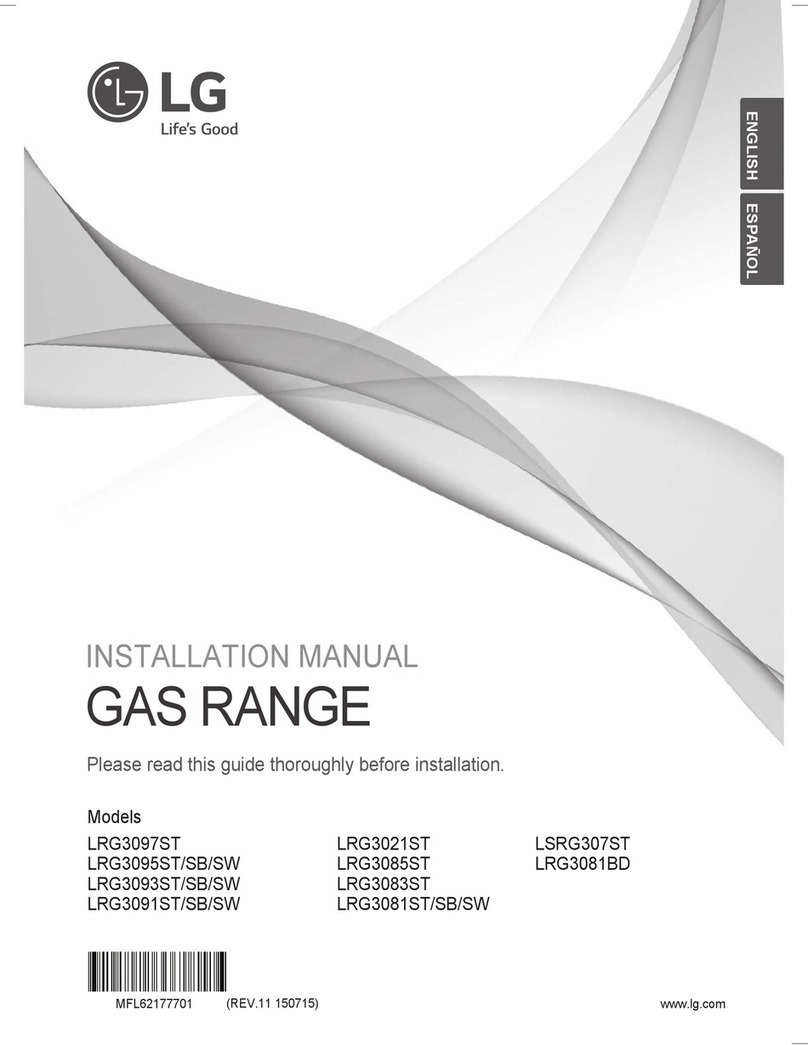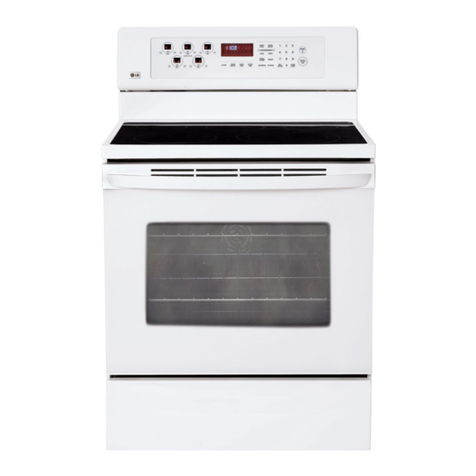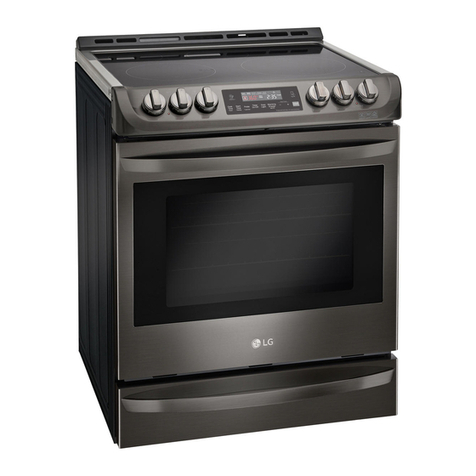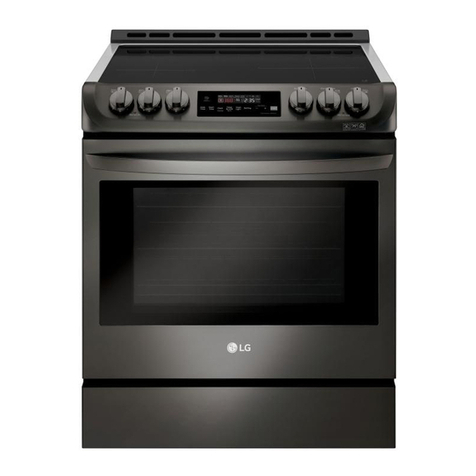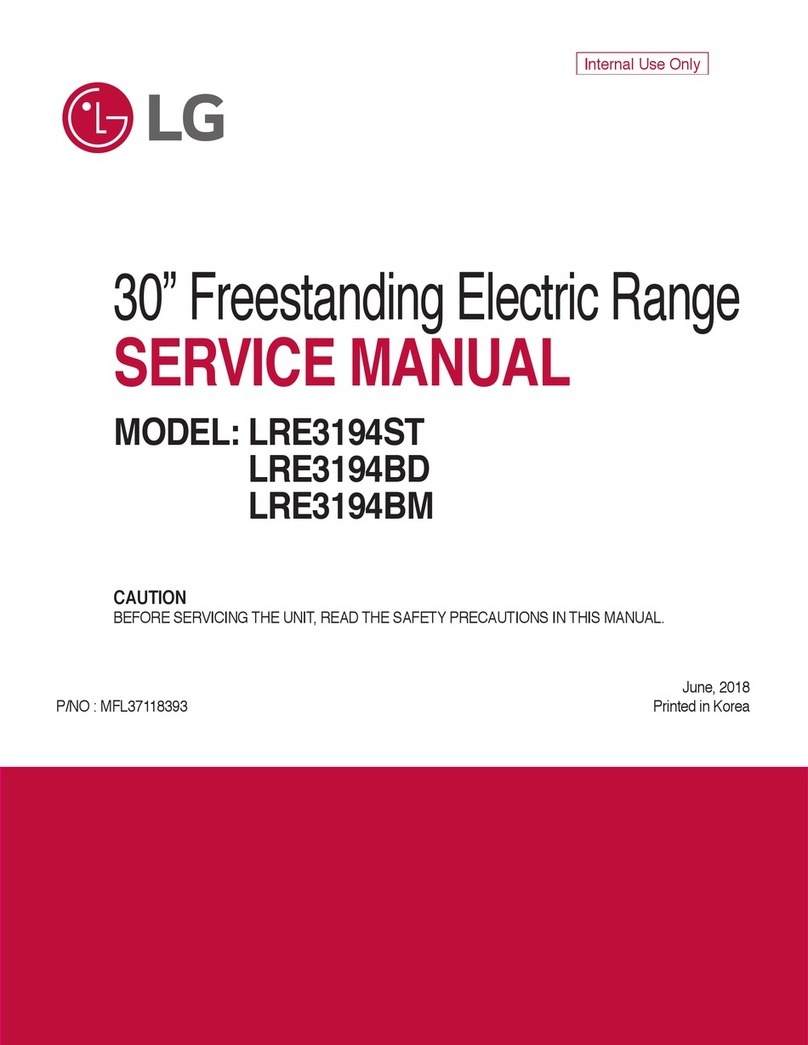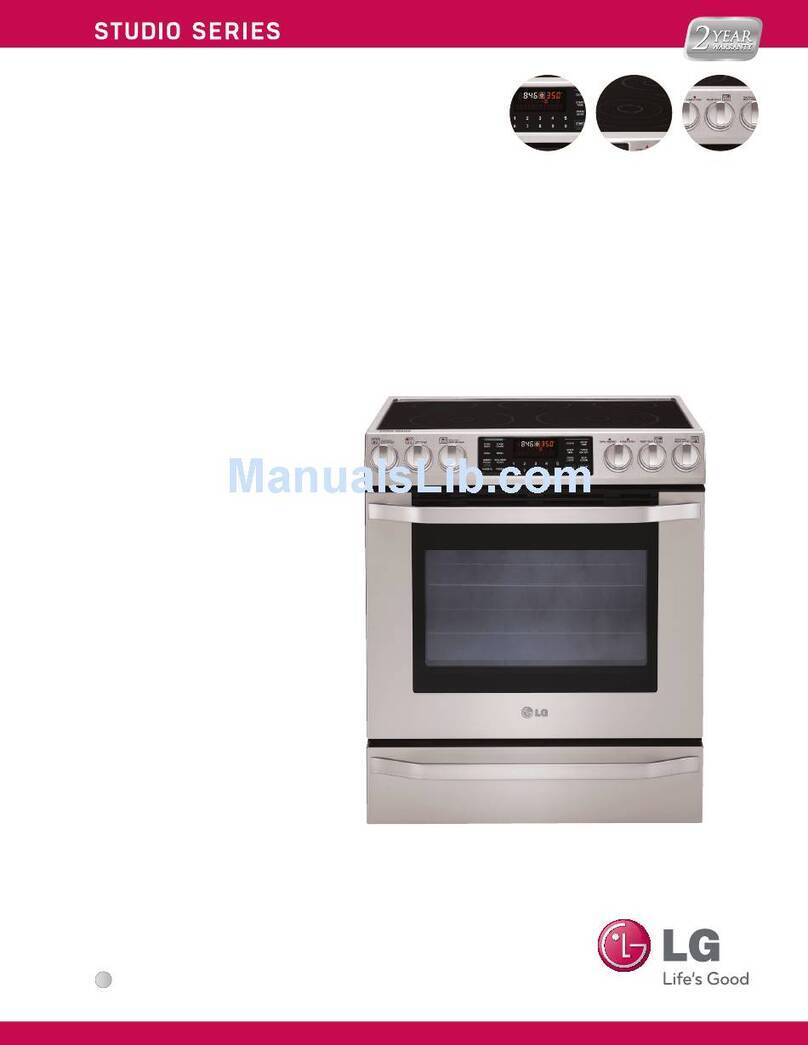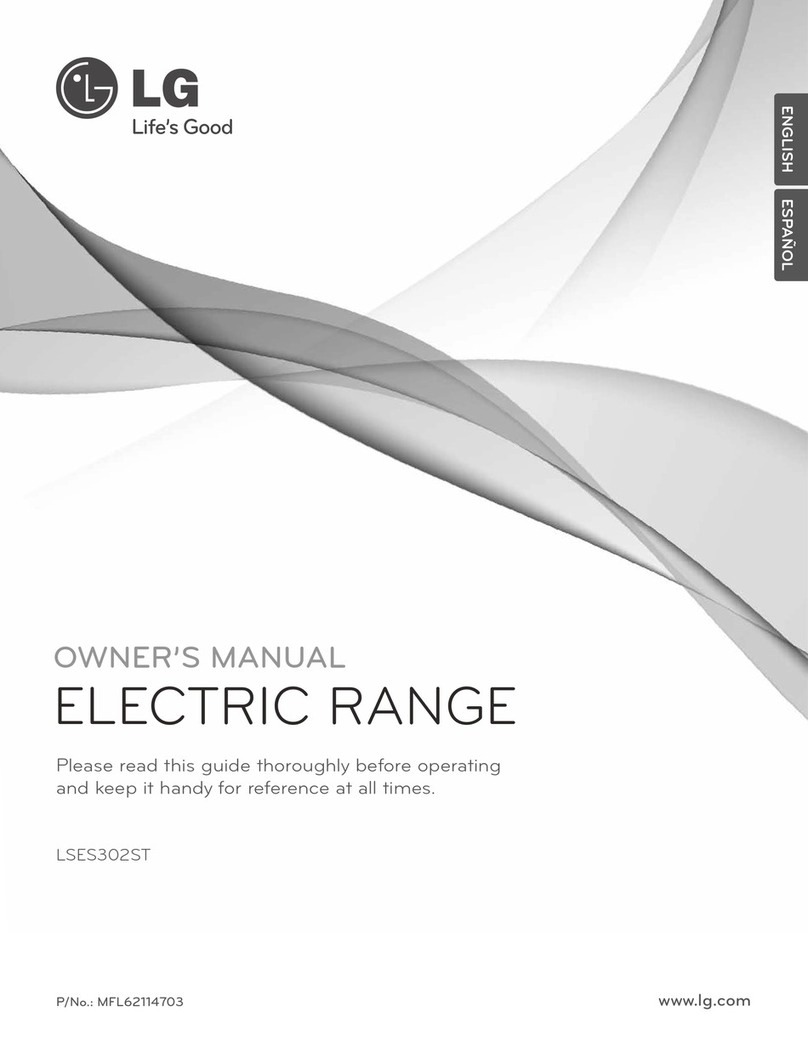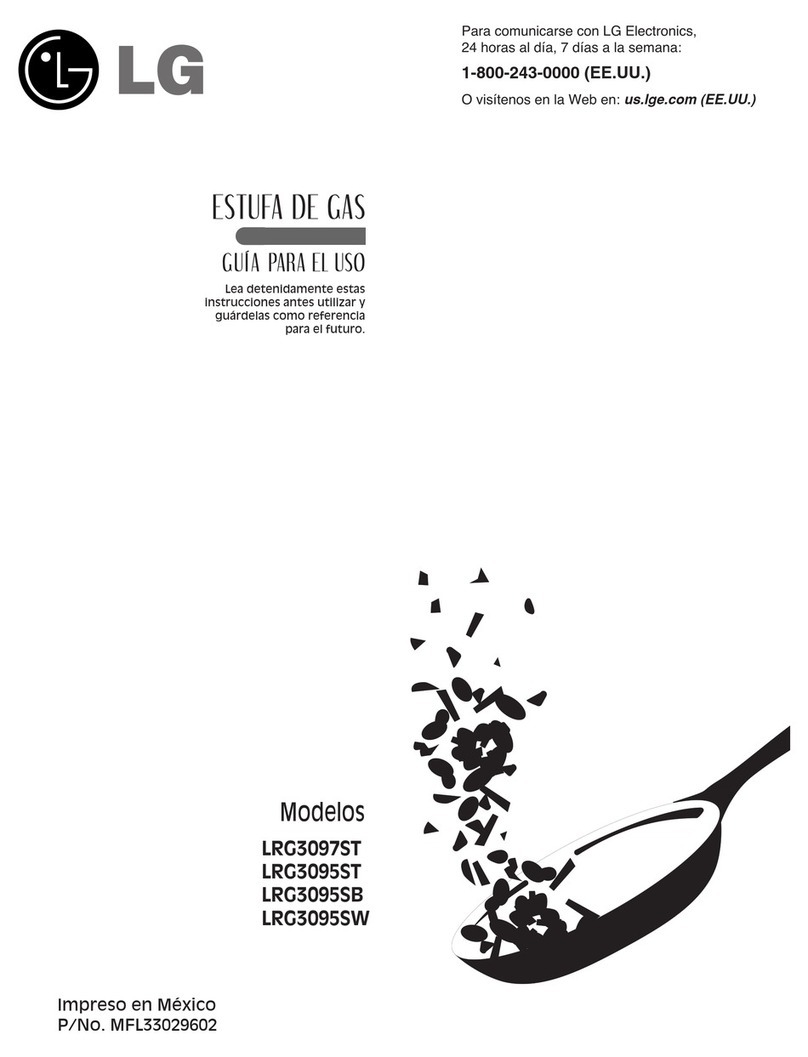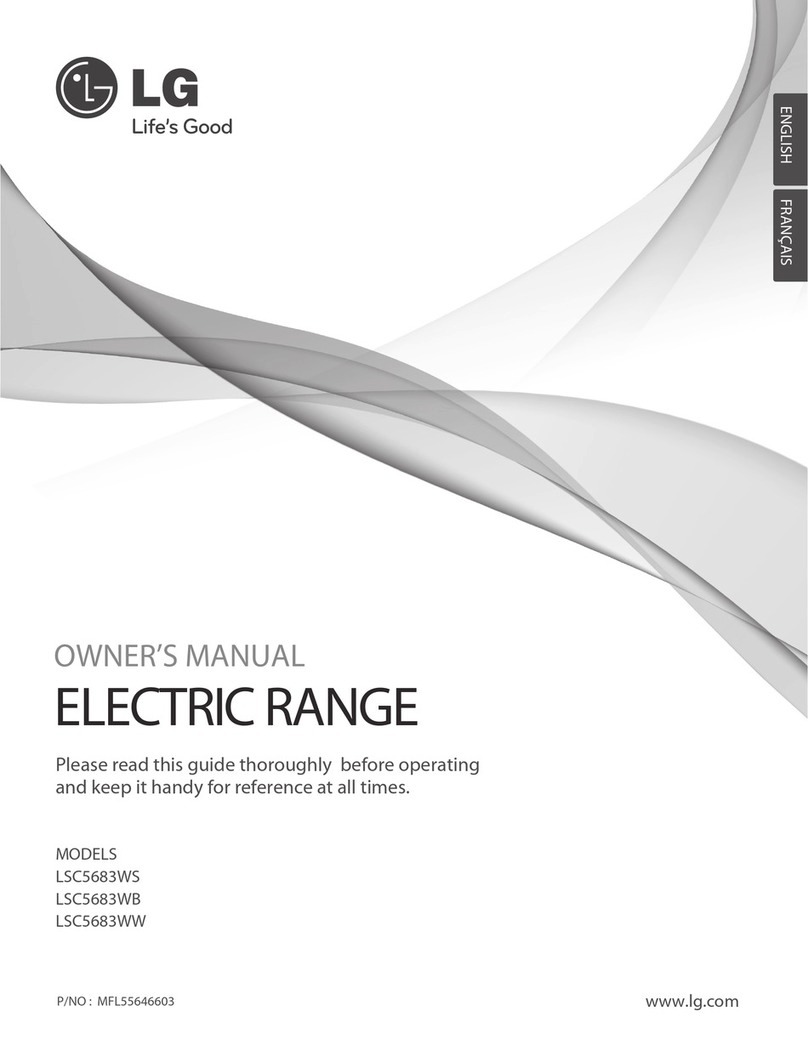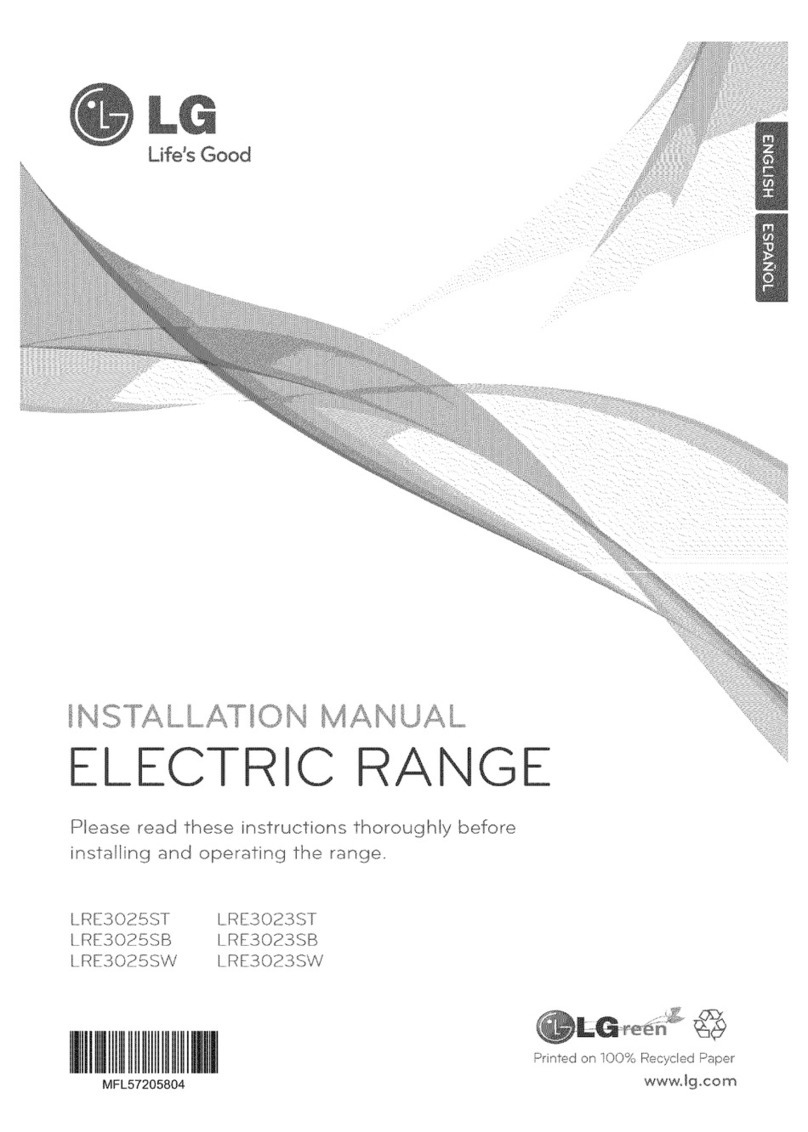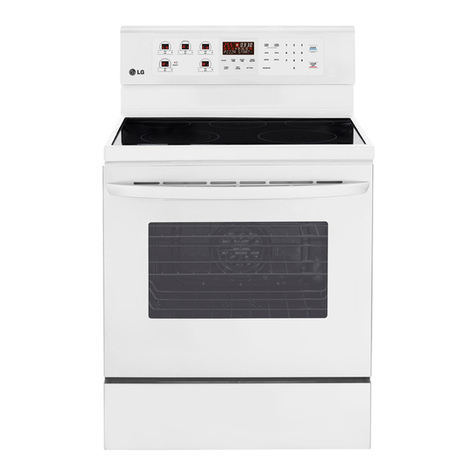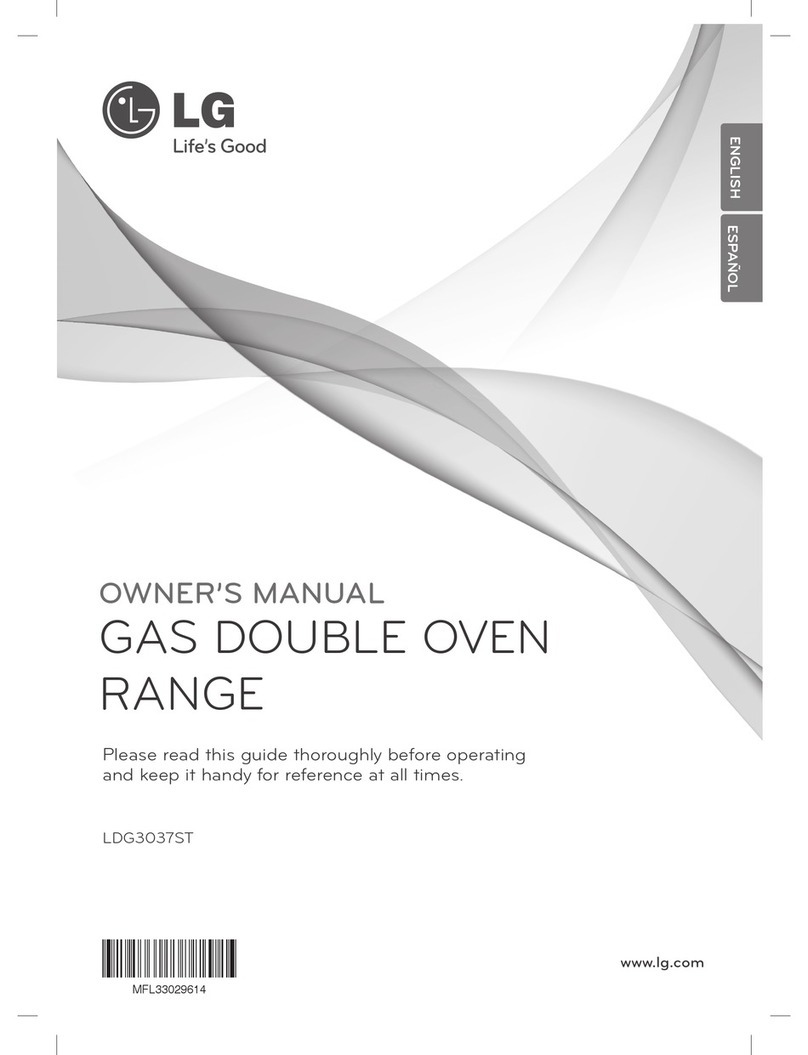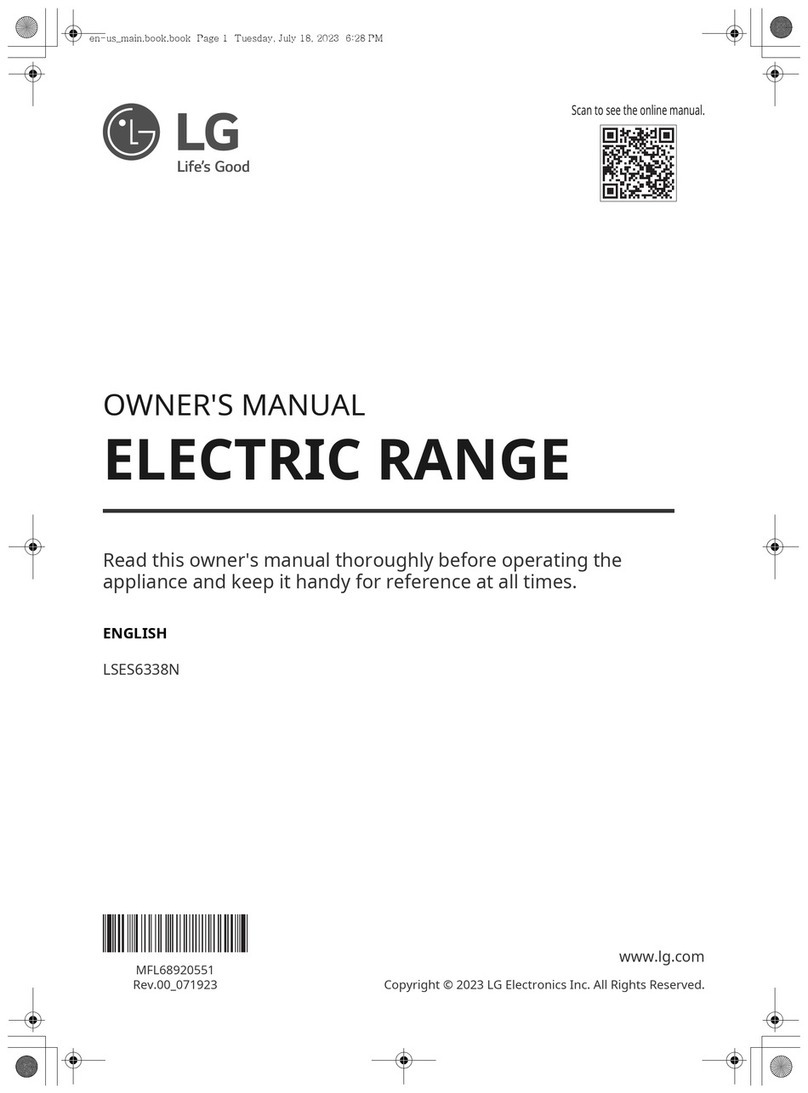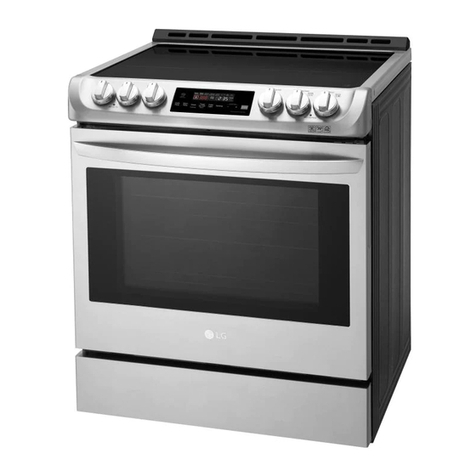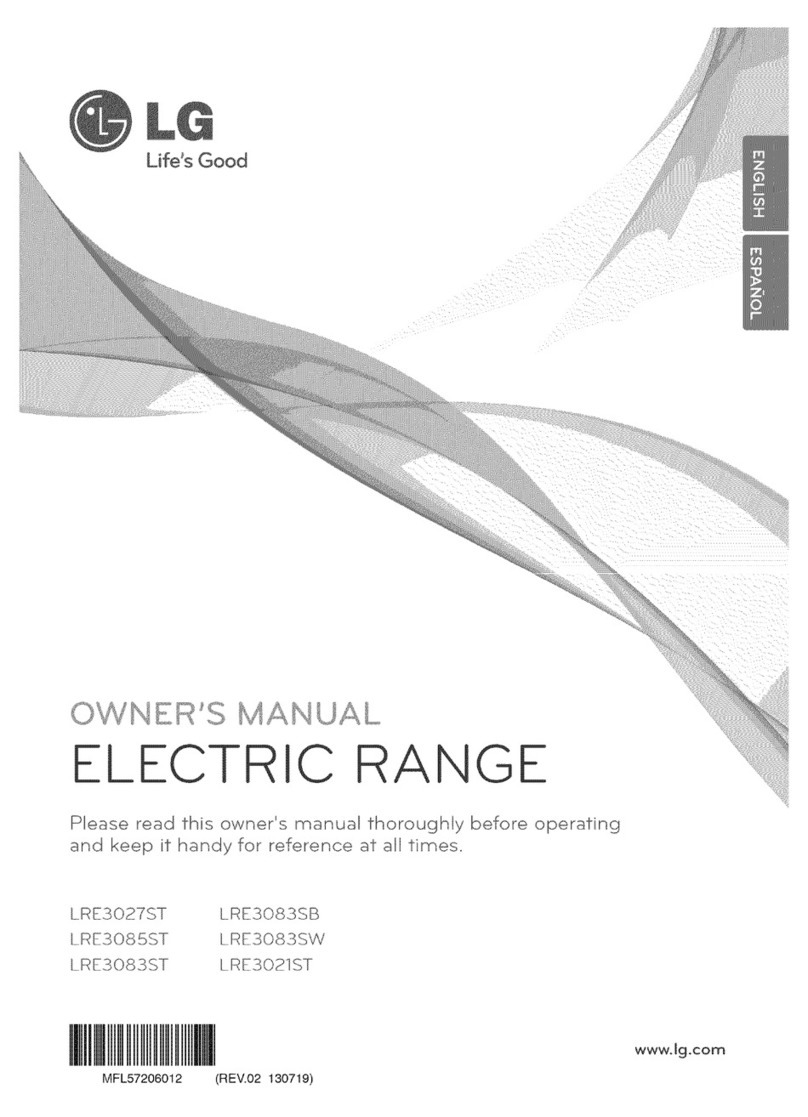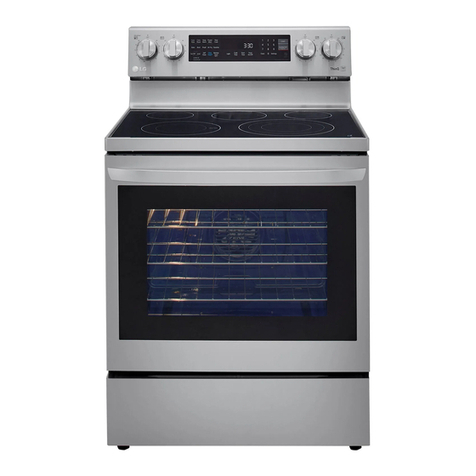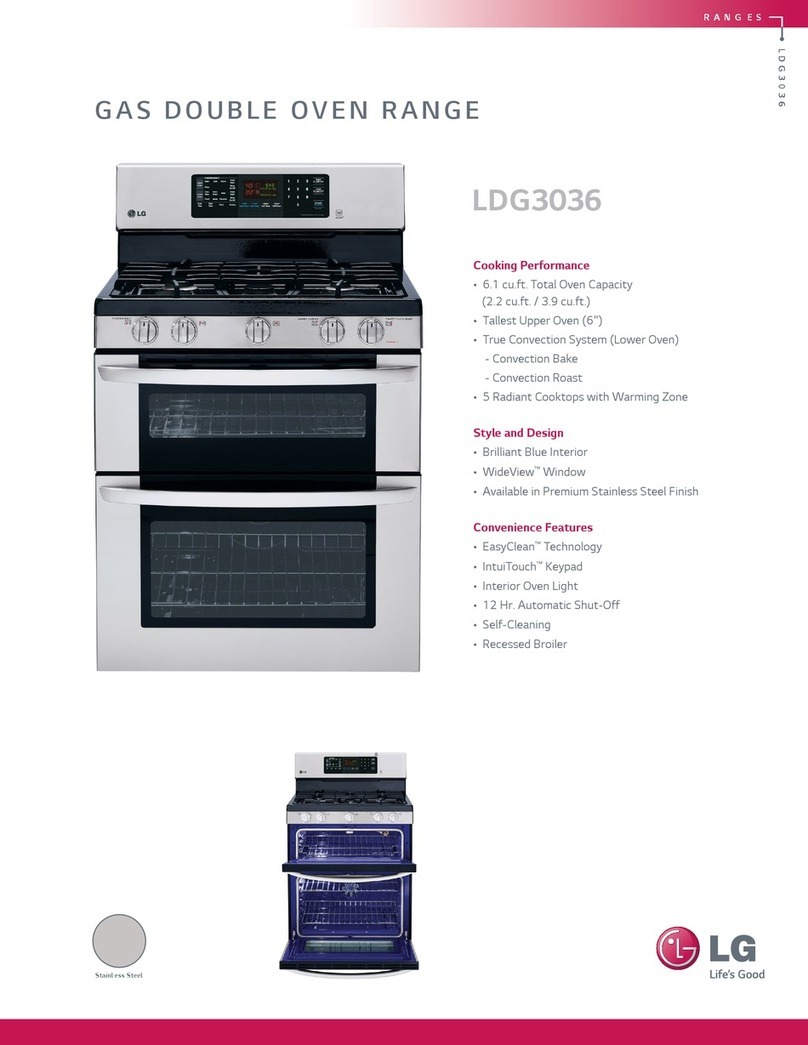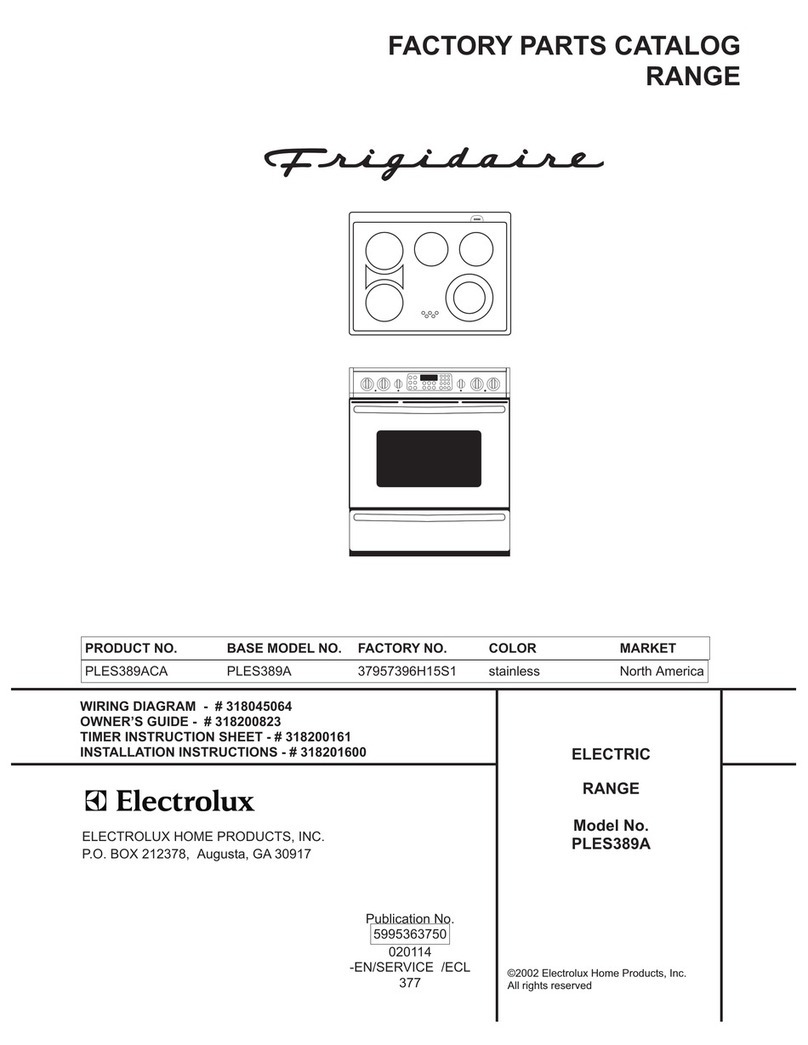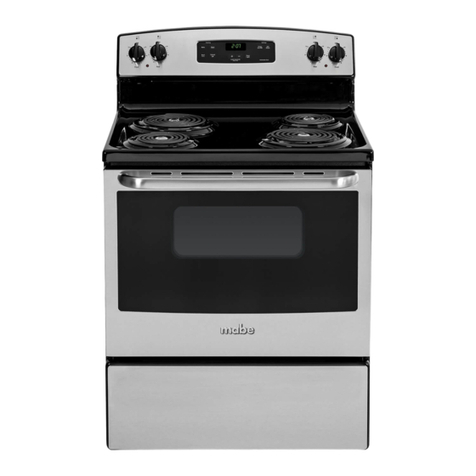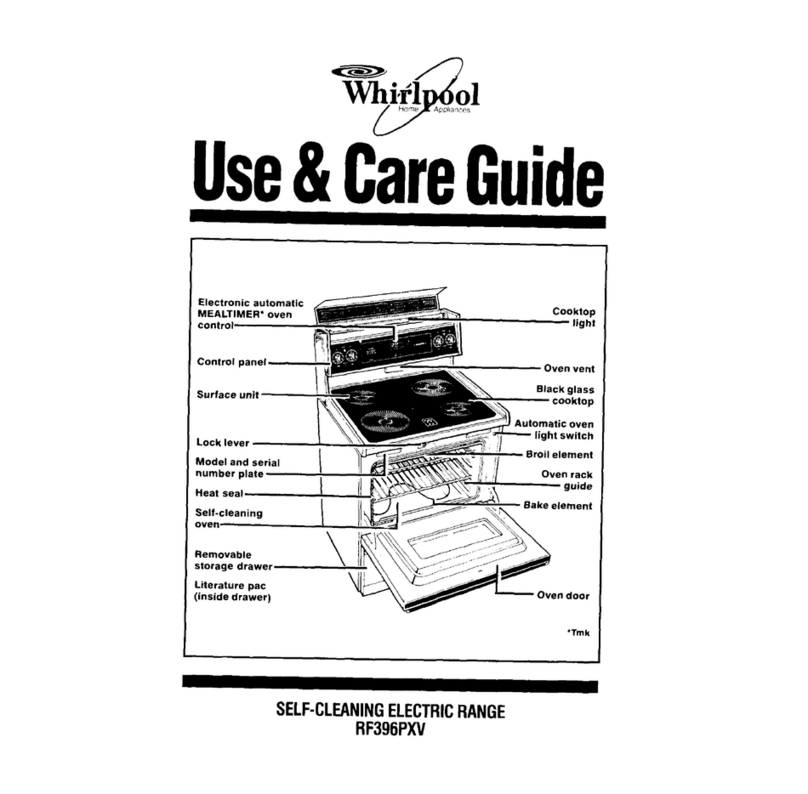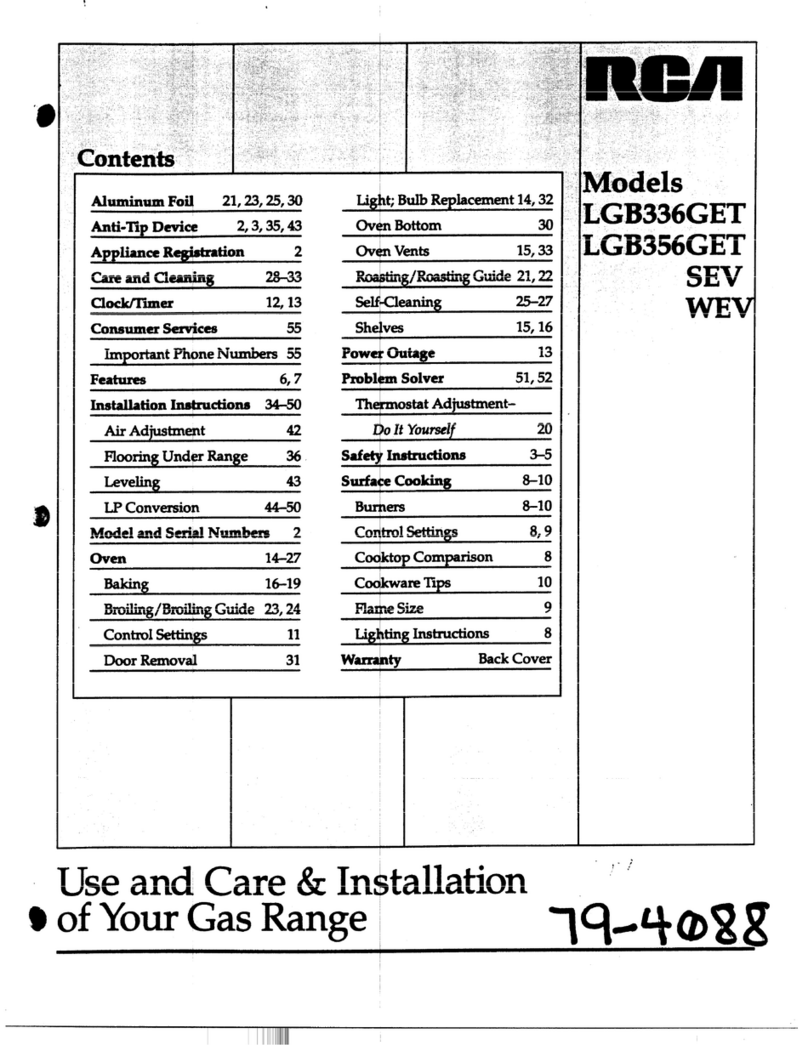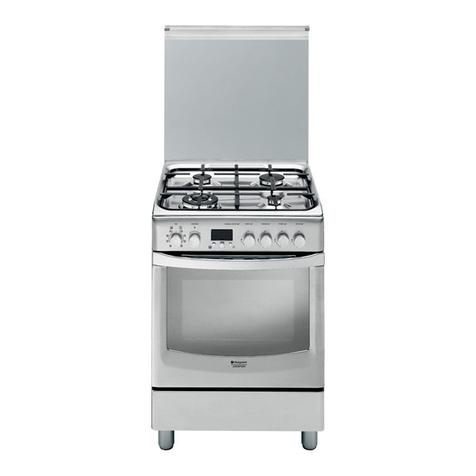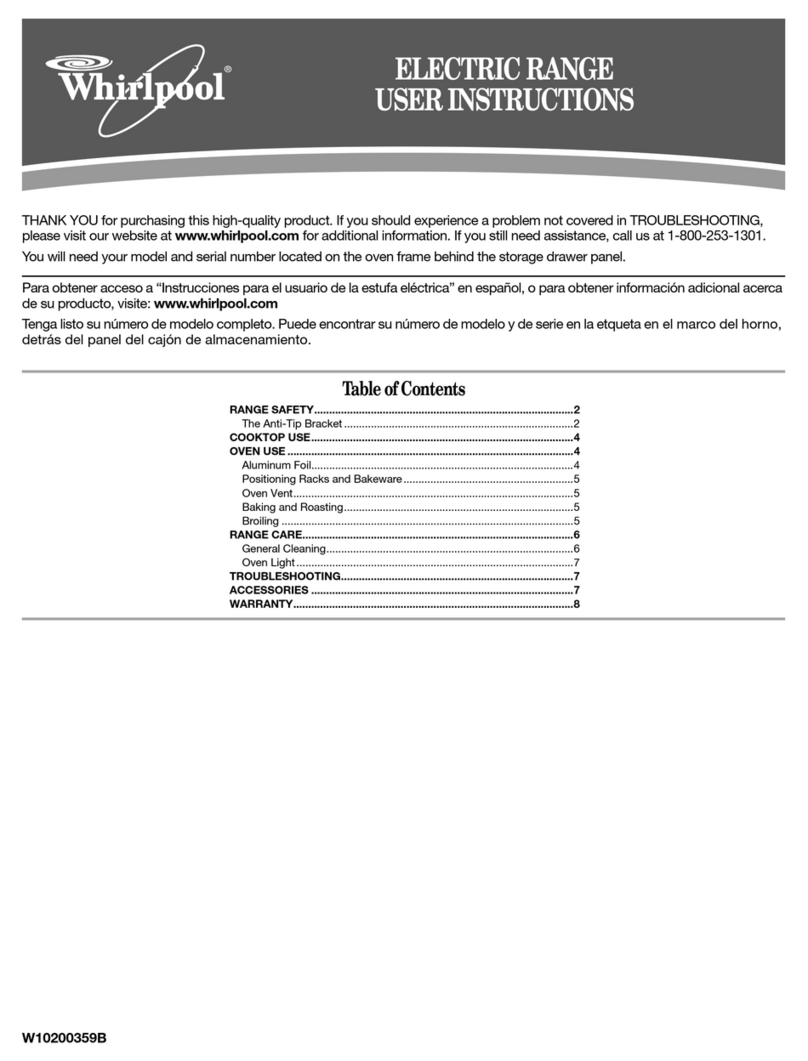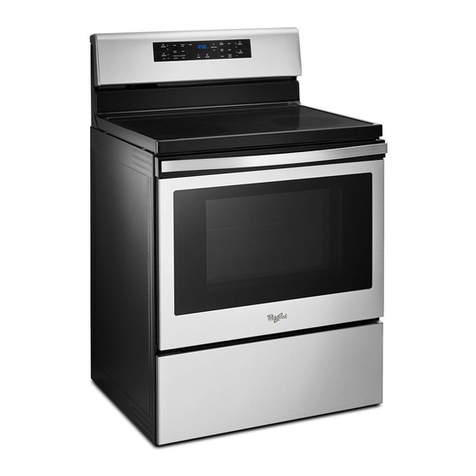LG LUTD4919SN User manual

LUTD4919SN
OWNER’S MANUAL
DUAL FUEL RANGE
Read this owner’s manual thoroughly before operating the
appliance and keep it handy for reference at all times.
•Do not store or use gasoline or other flammable vapors and liquids in the
vicinity of this or any other appliance.
•WHAT TO DO IF YOU SMELL GAS
- Do not try to light any appliance.
- Do not touch any electrical switch.
- Do not use any phone in your building.
- Immediately call your gas supplier from a neighbor's phone. Follow the
gas supplier's instructions.
- If you cannot reach your gas supplier, call the fire department.
•Installation and service must be performed by a qualified installer, service
agency, or the gas supplier.
If the information in this manual is not followed exactly, a fire or explosion
may result causing property damage, personal injury or death.
Never Operate the Top Surface Cooking Section of this Appliance Unattended
•Failure to follow this warning statement could result in fire, explosion, or
burn hazard that could cause property damage, personal injury, or death.
•If a fire should occur, keep away from the appliance and immediately call
your fire department.
•DO NOT ATTEMPT TO EXTINGUISH AN OIL/GREASE FIRE WITH WATER.
WARNING
WARNING
www.LGSIGNATURE.com
Copyright © 2016 - 2023 LG Electronics Inc. All Rights Reserved.
MFL68920507

2PRODUCT FEATURES
PRODUCT FEATURES
Multiple Gas Burner Sizes
Choose a burner to fit the size of your cookware.
Cooking multiple items at once is possible by using different burners at the
same time.
Self Clean & EasyClean
®
Useful for easy cleaning.
Wok Grate
Use the included wok grate to safely support a 12" to 14" round-bottomed
wok to stir-fry or saute meats, fish, or vegetables.

3
TABLE OF CONTENTS
ENGLISH
TABLE OF CONTENTS
2PRODUCT FEATURES
4IMPORTANT SAFETY
INSTRUCTIONS
12 PRODUCT OVERVIEW
12 Parts
12 Accessories
13 INSTALLATION
13 Installation Overview
13 Product Specifications
14 Before Installing the Range
16 Installing the Range
18 Optional Rear Filler
19 Providing Adequate Gas Supply
19 Connecting the Range to Gas
20 Connecting Electricity
23 Engaging the Anti-tip Device
23 Test Run
24 Assembling the Surface Burners
24 Checking Ignition of the Surface Burners
25 OPERATION
25 Control Panel Overview
26 Changing Oven Settings
30 Using the Gas Surface Burners
31 Burner Locations
31 Using the Gas Surface Burners
31 Setting the Flame Size
32 In Case of Power Failure
32 Range-Top Cookware
32 Using a Wok
32 Using the Wok Grate
33 Using Stove-Top Grills
33 Using the Griddle
34 Using the Oven
34 Before Using the Oven
34 Oven Vent
34 Using Oven Racks
34 Bake
35 Convection Mode
36 Recommended Baking and Roasting Guide
37 Broil
38 Recommended Broiling Guide
39 Warm
39 Proof
39 Meat Probe
40 Remote Start
41 SMART FUNCTIONS
41 LG ThinQ Application
42 FCC Notice
43 FCC RF Radiation Exposure Statement
43 Smart Diagnosis™ Feature
44 MAINTENANCE
44 Gas Surface Burners
45 Burner Grates
45 Cleaning the Cooktop Surface
45 Oven Air Vents
45 Control Panel
46 Front Manifold Panel and Knobs
46 EasyClean®
49 Self Clean
51 Changing the Oven Light
51 Cleaning the Exterior
53 Removing and Replacing the Lift-Off Oven
Doors
54 Door Care Instructions
55 TROUBLESHOOTING
55 FAQs
57 Before Calling for Service
60 LIMITED WARRANTY
Rev.17_031623

4IMPORTANT SAFETY INSTRUCTIONS
IMPORTANT SAFETY INSTRUCTIONS
Read and follow all instructions when using the range to prevent the risk of fire, electric
shock, personal injury, or damage. This guide does not cover all possible conditions that
may occur. Always contact your service agent or manufacturer about problems that you do
not understand.
Download this owner's manual at: http://www.LGSIGNATURE.com
This is the safety alert symbol. This symbol alerts you to potential hazards that
can result in property damage and/or serious bodily harm or death.
All safety messages will follow the safety alert symbol and either the word
WARNING or CAUTION. These words mean:
WARNING -Indicates a hazardous situation which, if not avoided, could result
in death or serious injury.
CAUTION -Indicates a hazardous situation which, if not avoided, could result
in minor or moderate injury.
ANTI-TIP DEVICE
WARNING
•TO REDUCE THE RISK OF TIPPING, THE APPLIANCE MUST BE SECURED
BY A PROPERLY INSTALLED ANTI-TIP DEVICE. TO CHECK IF THE DEVICE IS
INSTALLED PROPERLY, VERIFY THAT THE ANTI-TIP DEVICE IS ENGAGED, OR
GRASP THE TOP REAR EDGE OF THE RANGE BACK GUARD AND CAREFULLY
ATTEMPT TO TILT IT FORWARD. Refer to the installation section for instructions.
•A child or adult can tip the range and be killed.
•Install the anti-tip device to the structure and/or the range. Verify the anti-tip device
has been properly installed and engaged by following the guide of the Anti tip bracket
template.
•Engage the range to the anti-tip device by following the guide of the Anti tip bracket
template. Ensure the anti-tip device is re-engaged when the range is moved by following
the guide of the Anti tip bracket template.
•Re-engage the anti-tip device if the range is moved. Do not operate the range without
the anti-tip device in place and engaged.
•See installation instructions for details.
•Failure to do so can result in death or serious burns to children or adults.
•It is possible for a child or adult to tip the range and be killed.
•Verify that the anti-tip device has been properly installed and
attached to the floor or wall and engaged to the leveling leg of the
range.
•Do not operate the range without the anti-tip device in place and
engaged.
•Never remove the oven legs. The range will not be secured to the
anti-tip bracket if the legs are removed.
•Do not step or sit on the oven door. The range could be tipped and
injury might result from spilled hot liquid, food, or the range itself.
Anti-tip
bracket
Leveling
leg

5
IMPORTANT SAFETY INSTRUCTIONS
ENGLISH
•Do not rest large, heavy items such as whole turkeys on the open oven door. The range
could tip forward and cause injury.
•Reengage the anti-tip device after pulling the range out for cleaning, service, or any other
reason.
•Failure to follow these instructions can result in death or serious burns to children or
adults.
INSTALLATION SAFETY PRECAUTIONS
Have the installer show you the location of the range gas shut-off valve and how to shut it
off if necessary.
WARNING
•Make sure the range is properly installed and grounded by a qualified installer,
according to the installation instructions. Any adjustment and service should be
performed only by qualified gas range installers or service technicians.
•Make sure the range is properly adjusted by a qualified service technician or installer
for the type of gas (natural or LP) that is to be used. The range can be converted for
use with either type of gas. See the installation instructions.
•These adjustments must be done by a qualified service technician according to the
manufacturer’s instructions and all codes and requirements of the authority having
jurisdiction. Failure to follow these instructions could result in serious injury or property
damage. The qualified agency performing these adjustments assumes responsibility for
the conversion.
•Disconnect the electrical supply before servicing the appliance.
•Never use the appliance door as a step stool or seat, as this may result in tipping of the
appliance and serious injuries.
•This product should not be installed below ventilation type hood systems that direct air
in a downward direction.
Doing so may cause ignition and combustion problems with the gas burners resulting in
personal injury and may affect the cooking performance of the unit.
•To prevent fire hazard or electrical shock, do not use an adapter plug or an extension
cord, or remove the grounding prong from the electrical power cord. Failure to follow
this warning can cause serious injury, fire or death.
•To prevent poor air circulation, place the range out of the kitchen traffic path and out of
drafty locations.
•Do not attempt to repair or replace any part of the range unless it is specifically
mentioned in this manual. All other services should be referred to a qualified technician.
•Make sure that all packaging materials are removed from the range before operating it
to prevent fire or smoke damage should the packaging material ignite.
•After using the range for an extended period of time high floor temperatures may result.
Many floor coverings will not withstand this kind of use.
•Never install the range over vinyl tile or linoleum that cannot withstand such type of
use. Never install it directly over interior kitchen carpeting.

6IMPORTANT SAFETY INSTRUCTIONS
SAFETY PRECAUTIONS
Gas appliances can cause minor exposure to four of these substances, namely benzene,
carbon monoxide, formaldehyde and soot, caused primarily by the imperfect combustion
of natural or LP gas. Correctly adjusted burners, indicated by a bluish rather than a yellow
flame, will minimize imperfect combustion. Exposure to these substances can be minimized
by opening windows or using a ventilation fan or hood.
•DO NOT TOUCH HEATING ELEMENTS OR INTERIOR SURFACES OF OVEN. Heating
elements may be hot even though they are dark in color. Interior surfaces of an oven
become hot enough to cause burns. During and after use, do not touch or let clothing or
other flammable materials contact heating elements or interior surfaces of oven until they
have had sufficient time to cool. Other surfaces, such as oven vent openings and surfaces
near these openings, oven doors, and windows of oven doors, also get hot and may cause
burns if not cooled.
•Use care when opening door. The hot air and steam that escape can cause burns to
hands, face and eyes. Let hot air or steam escape from the oven before removing or
replacing food in the oven.
•Do not repair or replace any part of the appliance unless specifically recommended in the
manual. All other servicing should be performed by a qualified technician.
•Do not use harsh etching, abrasive cleaners or sharp metal scrapers to clean the oven
door glass since they can scratch the surface. Scratches may cause the glass to shatter.
WARNING
If the door glass, surface, or oven heating unit of the range are damaged, discontinue
use of the range and call for service.
•Do not operate the oven without the charcoal heater mesh.
•Do not use plastic to cover food. Use foil or oven-safe lids only.
•Do not allow anyone to climb, stand or hang on the door or cooktop. They could damage
the range and even tip it over, causing severe personal injury.
•Do not line the oven walls, racks, bottom, or any other part of the oven with aluminum foil
or any other material. Doing so will disrupt heat distribution, produce poor baking results
and cause permanent damage to the oven interior (aluminum foil will melt to the interior
surface of the oven)
•Never attempt to dry a pet in the oven.
•Never use your appliance for warming or heating the room.
•Always use pot holders or oven mitts when removing food from the oven or the surface
element. Cookware will be hot. Use only dry pot holders. Moist or damp pot holders on
hot surfaces may result in burns from steam. Do not let the pot holder touch hot heating
elements. Do not use a towel or other bulky cloth to remove food.
•Do not heat unopened food containers. Pressure in the containers may cause them to
burst which may result in injury.
•Large scratches or impacts to glass doors can lead to broken or shattered glass.
•Leak testing of the appliance must be conducted according to the manufacturer’s
instructions.

7
IMPORTANT SAFETY INSTRUCTIONS
ENGLISH
•To eliminate the risk of burns or fire by reaching over heated surface units, cabinet storage
space located above the surface units should be avoided. If cabinet storage is to be
provided, the risk can be reduced by installing a range hood that projects horizontally a
minimum of 5 inches beyond the bottom of the cabinets.
WARNING
•NEVER cover any slots, holes or passages in the oven bottom or cover an entire rack
with materials such as aluminum foil. Doing so blocks air flow through the oven and
may cause carbon monoxide poisoning. Aluminum foil linings may also trap heat,
causing a fire hazard.
•NEVER use this appliance as a space heater to heat or warm the room. Doing so may
result in carbon monoxide poisoning and overheating of the oven.
•Gas leaks may occur in the system and result in a serious hazard. Gas leaks may
not be detected by smell alone. Gas suppliers recommend you purchase and install
a UL approved gas detector. Install and use in accordance with the gas detector
manufacturer’s instructions.
•To prevent staining or discoloration, clean appliance after each use.
•Do not attempt to open or close the door or operate the oven until the door is properly
installed.
•Never place fingers between the hinge and front oven frame. Hinge arms are spring
mounted. If accidentally hit, the hinge will slam shut against the oven frame and injure
your fingers.
CAUTION
•Wear gloves when cleaning the range to avoid injury or burns.
•Do not use the oven for storing food or cookware.
•To prevent damage to the oven door, do not attempt to open the door when Lock is
displayed.
•Do not stand or place excessive weight on an open door. This could tip the range,
break the door, or injure the user.
•Do not use delayed baking for highly perishable foods such as dairy products, pork,
poultry, or seafood.
FLAMMABLE MATERIALS
WARNING
Be certain that all packing materials are removed from the appliance before operating.
Keep plastic, clothes, paper, and other flammable materials away from parts of the
appliance that may become hot.
•Do not store or use flammable material in the oven or near or on the cooktop. Flammable
materials include paper, plastic, pot holders, linens, wall coverings, curtains, and gasoline
or other flammable vapors and liquids such as grease or cooking oil. These materials can
be ignited when the oven and cooktop are in use.
•Wear proper apparel. Do not wear loose-fitting or hanging garments, which may ignite if
they contact hot surfaces, and cause severe burns.
•Do not use the oven for drying clothes. Only use the oven for its intended purpose.
•If a cabinet storage is provided directly above cooking surface, place items that are not
frequently used and can be safely stored in an area subjected to heat. Temperatures may
be unsafe for volatile items such as flammable liquids, cleaners or aerosol sprays.

8IMPORTANT SAFETY INSTRUCTIONS
ELECTRICAL SAFETY
CAUTION
Be certain that all packing materials are removed from the appliance before operating.
Keep plastic, clothes, paper, and other flammable materials away from parts of the
appliance that may become hot.
•Always disconnect power from the appliance before servicing.
•Do not use aluminum foil or any other material to line the oven bottom.
Improper installation of these liners may result in a risk of electric shock or fire.
•Do not allow aluminum foil or the temperature probe to contact heating elements.
WARNING
Before replacing the oven light bulb, switch off the electrical power to the oven at the
main fuse or circuit breaker panel. Failure to do so can result in severe personal injury,
death, or electrical shock.
DEEP FAT FRYER
•Use extreme caution when moving or disposing of hot grease.
•Always heat fat slowly, and watch as it heats.
•If frying combinations of oils and fats, stir them together before heating.
•Use a deep fat thermometer, if possible, to prevent overheating fat beyond the smoking
point.
•Use the least possible amount of fat for effective shallow or deep-fat frying. Filling the pan
with too much fat can cause spillovers when food is added.
CHILD SAFETY
•Do not leave small children unattended near the oven.
WARNING
Do not leave children alone or unsupervised near the appliance when it is in use or is
still hot. Children should never be allowed to sit or stand on any part of the appliance as
they could be injured or burned.
CAUTION
Do not store items of interest to children in cabinets above a range or on the back guard
of a range – children climbing on the range to reach items could be seriously injured.
•Never let a child hang on the oven door.
•Do not allow children to crawl into the oven.
•Let hot utensils cool in a safe place, out of reach of small children.
•Children should not be allowed to play with controls or other parts of the appliance.

9
IMPORTANT SAFETY INSTRUCTIONS
ENGLISH
SURFACE BURNERS
WARNING
•Even if the top burner flame goes out, gas is still flowing to the burner until the knob is
turned to the Off position. If you smell gas, immediately open a window and ventilate
the area for five minutes prior to using the burner. Do not leave the burners on
unattended.
•Use proper pan size. Do not use pans that are unstable or that can be easily tipped.
Select cookware with flat bottoms large enough to cover burner grates. To avoid
spillovers, make sure the cookware is large enough to contain the food properly. This
will both save cleaning time and prevent hazardous accumulations of food, since heavy
spattering or spillovers left on the range can ignite. Use pans with handles that can be
easily grasped and remain cool.
CAUTION
•Be sure that all surface controls are set in the Off position prior to supplying gas to the
range.
•Never leave the surface burners unattended at high flame settings. Boilovers may
cause smoke and greasy spillovers that may ignite.
•Always turn the knobs to the Lite position when igniting the top burners and make sure
the burners have ignited.
•Control the top burner flame size so it does not extend beyond the edge of the
cookware. Excessive flame is hazardous.
•Only use dry pot holders- moist or damp pot holders on hot surfaces may result in
burns from steam. Do not let pot holders come near open flames when lifting cookware.
Do not use towels or other bulky cloth items. Use a pot holder.
•If using glass cookware, make sure the cookware is designed for range-top cooking.
•To prevent burns from ignition of flammable materials and spillage, turn cookware
handles toward the side or back of the range without extending them over adjacent
burners.
•Never leave any items on the cooktop. The hot air from the vent may ignite flammable
items and will increase pressure in closed containers, which may cause them to burst.
•Carefully watch foods being fried at a high flame setting.
•Always heat fat slowly, and watch as it heats.
•If frying combinations of oils and fats, stir together before heating.
•Use a deep fat thermometer if possible to prevent fat from heating beyond the smoking
point.
•Use the least possible amount of fat for effective shallow or deep fat frying. Filling the
pan with too much fat can cause spillovers when food is added.
•Do not cook foods directly on an open flame on the cooktop.
•Do not use a wok on the surface burners if the wok has a round metal ring that is
placed over the burner grate to support the wok. This ring acts as a heat trap, which
may damage the burner grate and burner head. It may also cause the burner to work
improperly. This may cause carbon monoxide levels which are higher than what is
allowed by current standards, resulting in a health hazard.
•Foods for frying should be as dry as possible. Frost or moisture on foods can cause hot
fat to bubble up and spill over the sides of the pan.
•Never try to move a pan of hot fat, especially a deep fryer. Wait until the fat is cool.
•Do not place plastic items on the cooktop- they may melt if left too close to the vent.
•Keep all plastics away from the surface burners.

10 IMPORTANT SAFETY INSTRUCTIONS
CAUTION
•To prevent burns, always be sure that the controls for all burners are in the Off position
and all grates are cool before attempting to remove them.
•If you smell gas, turn off the gas to the range and call a qualified service technician.
Never use an open flame to locate a leak.
•Always turn the knobs to the Off position before removing cookware.
•Do not lift the cooktop. Lifting the cooktop can cause damage and improper operation
of the range.
•If the range is located near a window, do not hang long curtains that could blow over
the surface burners and catch on fire.
•Use care when cleaning the cooktop. The pointed metal ends on the electrodes could
cause injury.
•Stand away from the range while frying.
•Keep an eye on foods being fried at high or medium high heat settings.
ENERGY SAVING TIPS
•Multiple-rack cooking saves time and energy. Whenever possible, cook foods requiring the
same cooking temperature together in one oven.
•For optimal performance and energy savings, follow the guides on page 36 for proper rack
and pan placements.
•Match the size of the cookware to the amount of food being cooked to save energy when
heating. Heating ½ quart of water requires more energy in a 3-quart pot than in a 1-quart
pot.
•Match the size of the cooktop burner or element to the size of the cookware in use. Using
a large element for a small pan wastes heating energy, and the exposed surface of the
element is a burn or fire hazard.
•Reduce energy use by cleaning light oven soils with the EasyClean®feature instead of
self-clean.
•Avoid opening the oven door more than necessary during use. This helps the oven
maintain temperature, prevents unnecessary heat loss, and saves on energy use.
SAFETY DURING USE
•Do not touch the oven racks while they are hot.
•If a rack must be moved while the oven is hot, do not let the pot holder contact the hot
heating element in the oven.
•Use caution with the Timed Cook or Delayed Timed Cook features. Use the automatic
timer when cooking cured or frozen meats and most fruits and vegetables. Foods that can
easily spoil, such as milk, eggs, fish, meat or poultry, should be chilled in the refrigerator
first. Even when chilled, they should not stand in the oven for more than 1 hour before
cooking begins, and should be removed promptly when cooking is complete. Eating
spoiled food can result in sickness from food poisoning.
•Accessible parts may become hot when the grill is in use.
•Do not place food or cookware on the bottom of the oven cavity. Doing so will cause
permanent damage to the oven bottom finish.
•Do not use water on grease fires. Should an oven fire occur, leave the oven door closed
and turn the oven off. If the fire continues, throw baking soda on the fire or use a fire
extinguisher. Do not put water or flour on the fire. Flour may be explosive and water can
spread a grease fire and cause personal injury.

11
IMPORTANT SAFETY INSTRUCTIONS
ENGLISH
•When disposing of the range, cut off the power cord and remove the door.
•Do not make any attempt to operate the electric ignition oven during an electrical power
failure.
•Pull the oven rack to the stop-lock position when loading and unloading food from the
oven. This helps prevent burns caused by touching hot surfaces of the door and oven
walls.
•Do not use the oven if a heating element develops a glowing spot during use or shows
other signs of damage. A glowing spot indicates the heating element may fail and present
a potential burn, fire, or shock hazard. Turn the oven off immediately and have the heating
element replaced by a qualified service technician.
•When using cooking or roasting bags in the oven, follow the manufacturer’s directions.
SAFETY WHEN CLEANING
•Open a window or turn on a ventilation fan or hood before self-cleaning.
•If the oven is heavily soiled with oil, self-clean the oven before using the oven again. The
oil could cause a fire.
•Wipe up heavy soil on the bottom of the oven before using the Self Clean function.
•Do not use oven cleaners. Commercial oven cleaner or oven liner protective coating of
any kind should not be used in or around any part of the oven.
•Never keep pet birds in the kitchen. The health of birds is extremely sensitive to the fumes
released during an oven self-clean cycle. Fumes may be harmful or fatal to birds. Move
birds to a well-ventilated room.
•Clean in the self-clean cycle only parts listed in this manual. Before self-cleaning the oven,
remove the broiler pan, all oven racks, the meat probe and any utensils or food from the
oven.
•Important Instruction. The oven displays an F error code and sounds three long beeps
during the self-cleaning process if it malfunctions in the self-clean mode. Switch off the
electrical power to the main fuse or breaker and have the oven serviced by a qualified
technician.
•It is normal for the cooktop of the range to become hot during a self-clean cycle. Do not
touch the cooktop during a self-clean cycle.
•Never pour cold water over a hot oven for cleaning. Doing so may cause the oven to
malfunction.
•Make sure oven lights are cool before cleaning.
•Do not clean door gasket. The door gasket is essential for a good seal. Care should be
taken not to rub, damage, or move the gasket.
•If there is a fire in the oven during self-clean, turn the oven off and wait for the fire to go
out. Do not force the door open. Introduction of fresh air at self-clean temperatures may
lead to a burst of flame from the oven. Failure to follow this instruction may result in severe
burns.
•For your safety, do not use high-pressure water cleaners or steam jet cleaners to clean the
product.
COOK MEAT AND POULTRY THOROUGHLY
•To protect against food-borne illnesses, cook meat and poultry thoroughly. The USDA has
indicated the following as safe minimum internal temperatures for consumption:
•Ground meats: 160 °F
•All poultry: 165 °F
•Beef, veal, pork, or lamb: 145 °F
•Fish/seafood: 145 °F

12 PRODUCT OVERVIEW
PRODUCT OVERVIEW
Parts
Cooktop
controller
Upper
oven door
Lower
oven door
Cooktop
Oven mode knob
Model & serial
number plate
Gasket
Rack
Accessories
Included Accessories
Heavy rack (2ea)
Gliding rack (1ea) Wok grate (1ea) Meat probe (1ea) Griddle (1ea)
Rear ller (1ea) Owner’s manual
(1ea)
Anti-tip kit
Optional Accessories
Broiler pan
Grid
Anti-tip Screws (6ea) Anchors (6ea) Template
LP nozzle conversion kit
Cooktop nozzles (5ea) Installation guide (1ea) Choke (1ea) Set screw (1ea)
NOTE
•Contact the LG SIGNATURE Customer Information Center at 1-800-984-6306 if any accessories are
missing.
•For your safety and for extended product life, only use authorized components.
•The manufacturer is not responsible for product malfunction or accidents caused by the use of separately
purchased, unauthorized components or parts.
•The images in this guide may be different from the actual components and accessories, which are subject
to change by the manufacturer without prior notice for product improvement purposes.

13
INSTALLATION
ENGLISH
INSTALLATION
Installation Overview
Please read the following installation instructions first after purchasing this product or transporting it to another
location.
Check and choose the
proper location
Install anti-tip device Level the range Connect electric range
Conduit
connection
plate
Black White Red
Terminal
block
Plug in the power cordConnect the range to gas Engage the anti-tip device Test run
240 V or 208 V
Pressure
regulator
1
/
2
" Adapter
Product Specifications
The appearance and specifications listed in this manual may vary due to constant product improvements.
Oven Range Models LUTD4919SN
Description Dual Fuel Double Oven Range
Electrical requirements 6.9 kW 120/240 VAC or 5.2kW 120/208 VAC
Exterior Dimensions 29
7
/
8
" (W) x 37
7
/
8
" (H) x 28
15
/
16
" (D) (D with door closed)
75.9 cm (W) x 96.2 cm (H) x 73.5 cm (D) (D with door closed)
Height to cooking surface 36" (91.4 cm)
Net weight 210.5 lb (95.5 kg)
Total capacity
Upper Oven: 3.0 cu. ft.
Lower Oven: 4.3 cu. ft.
Total cap.: 7.3 cu. ft.

14 INSTALLATION
Before Installing the Range
WARNING
Tip - Over Hazard
A child or adult can tip the range and
be killed. Verify the anti-tip bracket
has been installed. Ensure the
anti-tip bracket is engaged when the
range is moved.
Do not operate the range without the
anti-tip bracket in place. Failure to
follow these instructions can result
in death or serious burns to children
and adults.
To check that leveling leg is
inserted into anti-tip bracket,
grasp the top rear edge
of the range and carefully
attempt to tilt it forward. Anti-tip
bracket
Leveling
leg
If you did not receive an anti-tip bracket with your
purchase, call 1-800-984-6306 to receive one at no
charge.
WARNING
•The information in this manual should be
followed exactly. Failure to do so may result
in fire, electrical shock, property damage,
personal injury, or death.
•Wear gloves during the installation
procedure. Failure to do so can result in bodily
injury.
•Make sure no parts came loose during shipping.
In the Commonwealth of Massachusetts
•This product must be installed by a licensed plumber or gas fitter.
•When using ball type gas shut-off valves, they must be the T-handle type.
•When using a flexible gas connector, it must not exceed 3 feet in length.
NOTE
•Observe all governing codes and ordinances.
•Have the installer show you the location of the circuit breaker or fuse. Mark it for easy reference.
•As when using any appliance generating heat, there are certain safety precautions you should follow.
•Be sure your range is installed and grounded properly by a qualified installer or service technician
according to the installation instructions.
•Any adjustment and service should be performed only by qualified gas range installers or service
technicians.

15
INSTALLATION
ENGLISH
Preparing for Installation
Tools Needed
Parts Provided
Template (1)
Parts not Provided
4-Wire cord or
3-Wire cord
(UL approved 40 or 50
AMP)
Strain relief
(For conduit
Installations only)
Anti-tip bracket kit (1)
Anchor sleeves (6) Lag bolts (6)
Phillips screwdriver
Level
Pipe wrench (2)
(one for support)
Flat-blade screwdriver
Open-end or
adjustable wrench
1
/
4
" Nut driver
Drill
Pliers
Safety glasses
Tape measure
Gloves
Materials You May Need
•Gas line shut-off valve
•Pipe joint sealant that resists action of natural and LP gases
•Flexible metal appliance connector (
3
/
4
" or
1
/
2
" NPT x
1
/
2
" I.D.)
Never use an old connector when installing a new range.
•Flare union adapter for connection to gas supply line (
3
/
4
" or
1
/
2
" NPT x
1
/
2
" I.D.)
•Flare union adapter for connection to pressure regulator on range (
1
/
2
" NPT x
1
/
2
" I.D.)
•Liquid leak detector or soapy water
•Lag bolt or
1
/
2
" O.D. sleeve anchor (for concrete floors only)

16 INSTALLATION
Installing the Range
Unpacking and Moving the Range
CAUTION
•You should use two or more people to move
and install the range. (Excessive Weight
Hazard) Failure to do so can result in back or
other injury.
•Do not use the door handles to push or
pull the range during installation or when
moving the range out for cleaning or
service. Doing so can result in serious damage
to the door of the range.
Remove packing material, tape and any temporary
labels from your range before using. Do not remove
any warning-type labels, the model and serial number
label, or the Tech Sheet that is located on the back of
the range.
To remove any remaining tape or glue, rub the area
briskly with your thumb. Tape or glue residue can also
be easily removed by rubbing a small amount of liquid
dish soap over the adhesive with your fingers. Wipe
with warm water and dry.
Do not use sharp instruments, rubbing alcohol,
flammable fluids, or abrasive cleaners to remove tape
or glue. These products can damage the surface of
your range.
The range is heavy and can be installed on soft
floor coverings such as cushioned vinyl or carpeting.
Use care when moving the range on this type of
flooring. Use a belt when moving the range to prevent
damaging the floor. Or slide the range onto cardboard
or plywood to avoid damaging the floor covering.
Choosing the Proper Location
CAUTION
•Avoid placing cabinets above the range. To
minimize the hazard caused by reaching over
the open flames of operating burners, install a
ventilation hood over the range that projects
forward at least five inches beyond the front of
the cabinets.
•Do not locate your range where it may be
subject to strong drafts. Any openings in the
floor or wall behind the range should be sealed.
Make sure the openings around the base of
the range that supply fresh air for combustion
and ventilation are not blocked by carpeting or
woodwork.
•This range is for indoor, household use
only. Do not install the range in areas exposed
to the weather and/or water.
•If the range is located near a window, do not
hang long curtains or paper blinds on that
window.
•Make sure wall covering, countertop and
cabinets around the range can withstand
the heat (up to 194 °F) generated by the
range. Discoloration, delamination or melting
may occur. This range has been designed to
comply with the maximum allowable wood
cabinet temperature of 194 °F.
•Before installing the range in an area
covered with linoleum or other synthetic
floor covering, make sure the floor covering
can withstand temperatures of at least
160 °F(70°C).
•Use an insulated pad or
1
/
4
in. (0.64 cm)
plywood under the range if installing the
range over carpeting.
The range should always be plugged into its own
individual properly grounded electrical outlet. This
prevents overloading house wiring circuits which
could cause a fire hazard from overheated wires. It is
recommended that a separate circuit serving only this
appliance be provided.
This appliance must not be installed with a ventilation
system that blows air downward toward the range.
This type of ventilation system may cause ignition and
combustion problems with the gas cooking appliance
resulting in personal injury or unintended operation.
When the floor covering ends at the front of the
range, the area that the range will be installed on
should be built up with plywood to the same level
or higher than the floor covering. This will allow the
range to be moved for cleaning and servicing, as well
as provide proper air flow to the range.

17
INSTALLATION
ENGLISH
Dimensions and Clearances
NOTE
Save for the use of the local electrical inspector.
3" (7.6 cm) 24"
(60.9 cm)
24"
(60.9 cm)
36"
(91.4 cm)
29.8"
(75.7 cm)
15" (38 cm)
11" (28 cm)
2.5" (6.3 cm)
2.5"
(6.3 cm)
9"
(23 cm)
4"
(10 cm)
9"
(23 cm)
4"
(10 cm)
6"
(15.2 cm)
5"
(13 cm) 6"
(15.2 cm)
25"
(63.5 cm)
36"
(91.4 cm)
3" (7.6 cm)
Acceptable
gas pipe and
electrical
outlet area
Normal counter
top depth
Counter
top height
Cabinet
opening
Wall
Center
Cabinet
A = 30" (76.2 cm) For U.S.A
= 30" (76.2 cm) ~ 31" (78.7 cm) For CANADA
For installation in Canada, a free-standing range is not to be installed closer than
15
/
32
" (12 mm) from any
adjacent surface.
30"
(76.2 cm)
36"
(91.4 cm)
**15"
(38.1 cm)
*30" (76.2 cm)
Minimum 13"
(33.0 cm)
Maximum
depth for
cabinets above
countertops
Front edge of
the range side
panel forward
from cabinet
1
/
4
"
(0.64 cm)
5"(12.7 cm)
Minimum
0"
To cabinets
below
cooktop and
at the range
back
Minimum Dimensions
* 30" (76.2 cm) minimum clearance between the top of the cooking surface and the bottom of an unprotected
wood or metal cabinet; or 24" (60.9 cm) minimum when bottom of wood or metal cabinet is protected by not less
than
1
/
4
" (0.64 cm) flame retardant millboard covered with not less than no. 28 MSG sheet steel, 0.015"
(0.381
mm)
stainless steel, 0.024" (0.610 mm) aluminum or 0.020" (0.508 mm) copper.
** 15" (38.1 cm) minimum between countertop and adjacent cabinet bottom.

18 INSTALLATION
Installing the Anti-tip Device
Anti-tip
bracket
Leveling
leg
WARNING
Tip - Over Hazard
A child or adult can tip the range and
be killed. Verify the anti-tip bracket
has been installed. Ensure the anti-tip
bracket is engaged when the range
is moved. Do not operate the range
without the anti-tip bracket in place.
Failure to follow these instructions
can result in death or serious burns to
children and adults.
To check that leveling leg is
inserted into anti-tip bracket,
grasp the top rear edge
of the range and carefully
attempt to tilt it forward.
Wall plate
Anti-tip
bracket
Screw must
enter wood or
concrete
Locate the anti-tip bracket using the template
An anti-tip bracket is packaged with the template.
The instructions include necessary information to
complete the installation. Read and follow the range
installation instruction sheet (template).
WARNING
•A child or adult can tip the range and be killed.
•Install the anti-tip device to the structure and/
or the range. Verify the anti-tip device has been
properly installed and engaged by following the
guide of the Anti tip bracket template.
•Engage the range to the anti-tip device by
following the guide of the Anti tip bracket
template. Ensure the anti-tip device is re-
engaged when the range is moved by following
the guide of the Anti tip bracket template.
•Re-engage the anti-tip device if the range is
moved. Do not operate the range without the
anti-tip device in place and engaged.
•See installation instructions for details.
•Failure to do so can result in death or serious
burns to children or adults.
Leveling the Range
Level the range by adjusting the leveling legs with a
wrench. Extending the legs slightly may also make it
easier to insert the rear leg into the anti-tip bracket.
Use a level to check your adjustments. Place the level
diagonally on the oven rack, and check each direction
for level.
First check direction .
Then check direction . If the level doesn’t show level
on the rack, adjust the leveling legs with a wrench.
1
2
Optional Rear Filler
If the counter does not bridge the opening at the rear
wall, use the rear filler kit provided with the slide-in
range.
NOTE
If the countertop depth is greater than 26" there
will be a gap between the filler kit and the back
wall.
If the countertop depth is less than 25", the control
panel will not sit flush with the countertop.

19
INSTALLATION
ENGLISH
Installing the Rear Filler
1Using a screwdriver, remove the upper four
screws that attach the rear bracket and loosen
the lower two screws.
2Place the rear filler on the rear bracket.
3Tighten the two lower screws on the rear
bracket. Insert one of the screws removed in
step 1 in the slot at each end of the rear filler.
4Store the remaining two screws with these
instructions for future use.
Upper screws
Lower screws
Rear Filler
Rear bracket
Providing Adequate Gas
Supply
The range is designed to operate at a pressure of
5" of water column on natural gas or 10" of water
column on LP.
Make sure you are supplying the range with the type
of gas for which it is configured.
This range is convertible for use on natural or LP gas.
When using this range on LP gas, conversion must
be made by a qualified LP installer before attempting
to operate the range.
For proper operation, the pressure of natural gas
supplied to the regulator must be between 5" and 13"
of water column.
For LP gas, the pressure supplied to the regulator
must be between 10" and 13" of water column. When
checking for correct operation of the regulator, the
inlet pressure must be at least 1" more than the
operating (manifold) pressure as given above.
The pressure regulator located at the inlet of the
range must remain in the supply line regardless of
which type of gas is being used.
A flexible metal appliance connector used to connect
the range to the gas supply line should have an I.D.
of
5
/
8
" and a maximum length of 5 feet. In Canada,
flexible connectors must be single wall metal
connectors less than 6 feet in length.
Connecting the Range to Gas
This appliance must be installed in accordance with
local codes or, in the absence of local codes, with the
National Fuel Gas Code, ANSI Z223.1/NFPA 54 or,
in Canada, the Natural Gas and Propane Installation
Code, CSA B149.1.
Shut off the range gas supply valve before removing
the old range and leave it off until the new hook-up
has been completed.
Because hard piping restricts movement of the range,
a CSA International-certified flexible metal appliance
connector should be used unless local codes require
a hard-piped connection.
A manual valve shall be installed in an accessible
location in the gas piping external to the appliance
for the purpose of turning on or shutting off gas to the
appliance.
Never reuse an old connector when installing a new
range.
To protect against gas leaks, use a qualified pipe joint
sealant on all external threads.
1Install a male
1
/
2
" or
3
/
4
" flare union adapter to the
NPT internal thread of the manual shut-off valve,
taking care to back-up the shut-off valve to keep
it from turning.
2Install a male
1
/
2
" flare union adapter to the
1
/
2
"
NPT internal thread at the inlet of the pressure
regulator. Use a backup wrench on the pressure
regulator fitting to prevent damage.
3Connect a flexible metal appliance connector to
the adapter on the range. Position the range to
permit connection at the shut-off valve.
4When all connections have been made, be sure
all range controls are in the Off position and turn
on the main gas supply valve. Gas leaks may
occur in your system and create a hazard. Gas
leaks may not be detected by smell alone.
Check all gas connection joints and fittings for
leaks with a non-corrosive leak detection fluid,
then wipe off.
Gas suppliers recommend you purchase and
install a UL approved gas detector. Install and use
in accordance with the installation instructions.
WARNING
•Do not use a flame to check for gas leaks.
•The appliance and its individual shut-off valve
must be disconnected from the gas supply piping
system during any pressure testing of that system
at test pressures in excess of
1
/
2
psi (3.5 kPa).
•The appliance must be isolated from the gas
supply piping system by closing its individual
manual shut-off valve during any pressure
testing of the gas supply piping system at test
pressures equal to or less than
1
/
2
psi (3.5 kPa).

20 INSTALLATION
Flexible Connector Hookup
1
/
2
" Adapter
1
/
2
" Adapter
1
/
2
" Adapter
Pressure
regulator
Flex connector
(6 ft. max.) Gas shut-off valve
1
/
2
" or
3
/
4
"
Gas pipe
Gas Flow into Range
Installer: Inform the consumer of the location of the gas
shutoff valve.
Pressure Regulator Position
Pressure Regulator
Connecting Electricity
Electrical Requirements
If an external electrical source is utilized, the appliance,
when installed, must be electrically grounded in
accordance with local codes or, in the absence of local
codes, with the National Electrical Code, ANSI/NFPA
70 or the Canadian Electric Code, CSA C22.1-02.
All wiring should conform to Local and NEC codes.
This range requires a single-phase, 3 wire, A.C
120/208 V or 120/240 V 60 Hz electrical system. Use
only a 3-conductor or a 4-conductor UL- listed range
cord with closed-loop terminals, open-end spade
lugs with upturned ends or similar termination. Do not
install the power cord without a strain relief.
A range cord rated at 40 amps with 120/208 or 120/240
minimum volt range is required. If a 50 amp range
cord is used, it should be marked for use with 1
3
/
8
"
diameter connection openings. This appliance may
be connected by means of a conduit or power cord.
If a conduit is being used, go to page 22 for 3 wire
conduit connections or 4 wire conduit connections.
WARNING
•Allow 2 to 3 ft (61.0 cm to 91.4 cm) of slack
in the line so that the range can be moved if
servicing is ever necessary.
•The power supply cord and plug should
not be modified. If it will not fit the outlet,
have a proper outlet Installed by a qualified
electrician.
•Using an extension cord to connect the
power is prohibited. Connect the power cord
and plug directly.
•Electrical ground is required on this appliance.
•Make sure that the power cord is not pinched
by the range or heavy objects. Failure to do so
can result in serious burns or electrical shock.
•Do not use a damaged power plug, power
cord, or loose power outlet.
•Do not put a fuse in a neutral or ground circuit.
•Do not connect the ground wire to plastic
plumbing lines, gas lines, or hot water pipes.
Specified power-supply-cord kit rating
Range rating, watts Specified
rating of
power
supply-
cord kit,
amperes
Diameter (inches)
of Range
connection
Opening
120/240
volts
3-wire
120/208
volts
3-wire
Power
cord Conduit
8,750 -
16,500
16,501 -
22,500
7,801 -
12,500
12,501 -
18,500
40 or 50A
50
1 3/8"
1 3/4"
1 1/8"
1 3/8"
3, 4 - Wire electrical wall Receptacle
4 Wire receptacle (14-50R)
3 Wire receptacle (10-50R)
Connecting the Power Cord
The rear access cover must be removed. Loosen the
two screws with a screwdriver. The terminal block will
then be accessible.
Access cover
Other manuals for LUTD4919SN
3
Table of contents
Other LG Range manuals
Popular Range manuals by other brands

Bosch
Bosch HEZ9TK36UC installation instructions
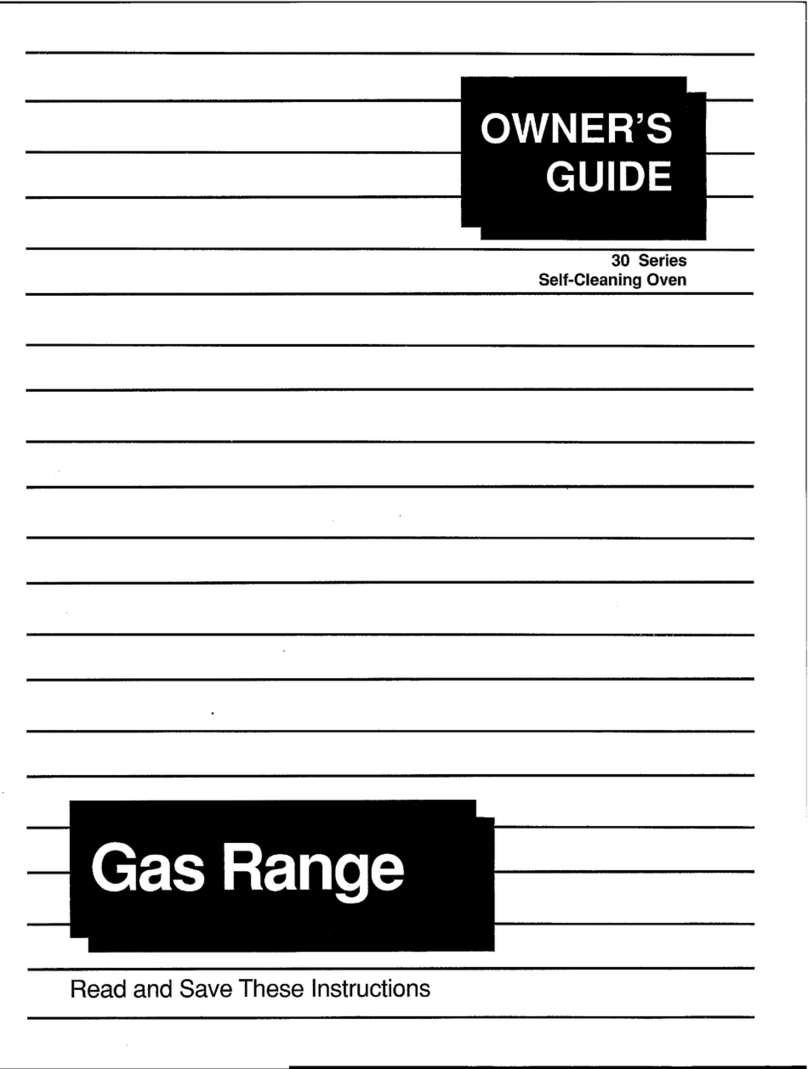
White
White 30 series owner's guide

Viking
Viking VESC530 Quick reference guide

Whirlpool
Whirlpool GS395LEG Use & care guide

Viking
Viking Professional Freestanding Dual Fuel Quick reference guide
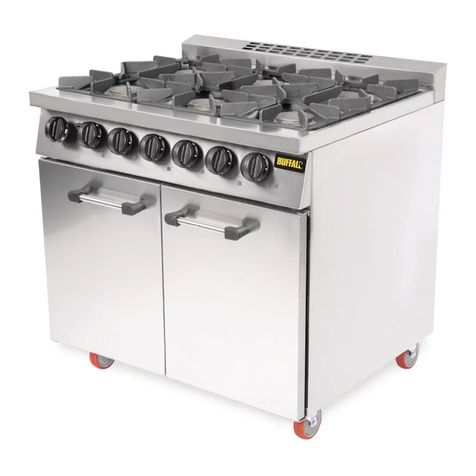
Buffalo
Buffalo CT253 Installation, operating and maintenance instructions
